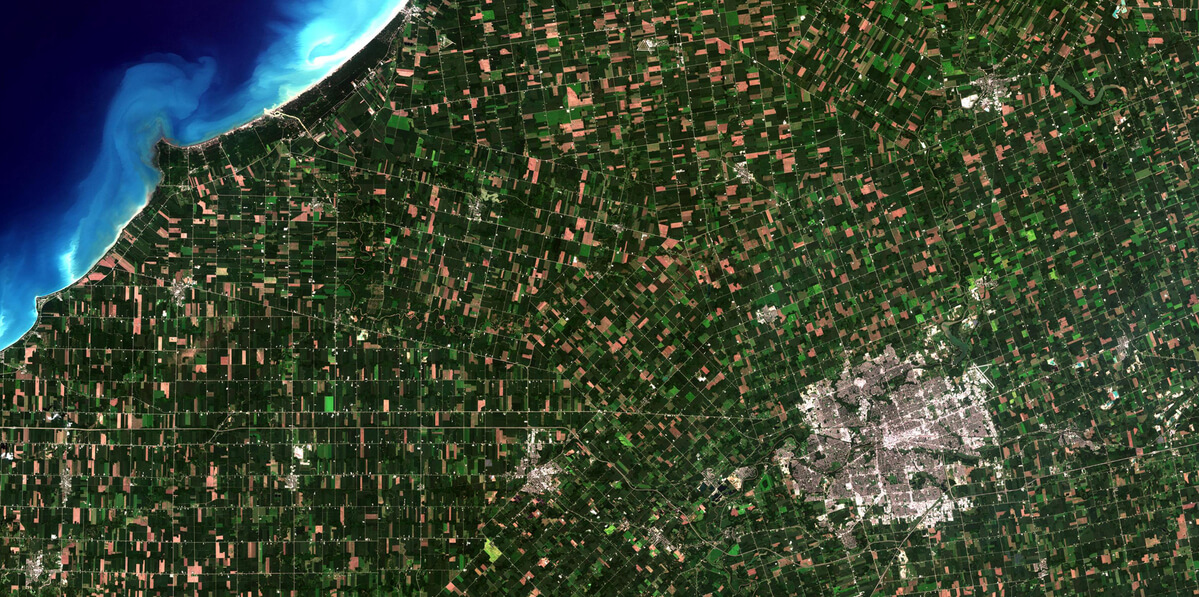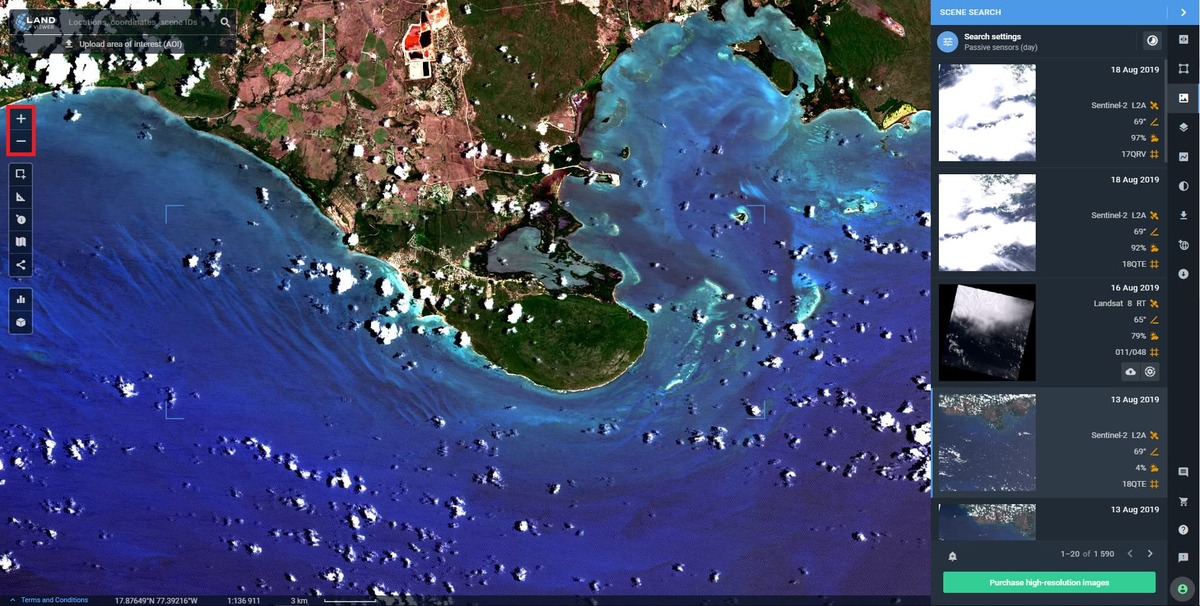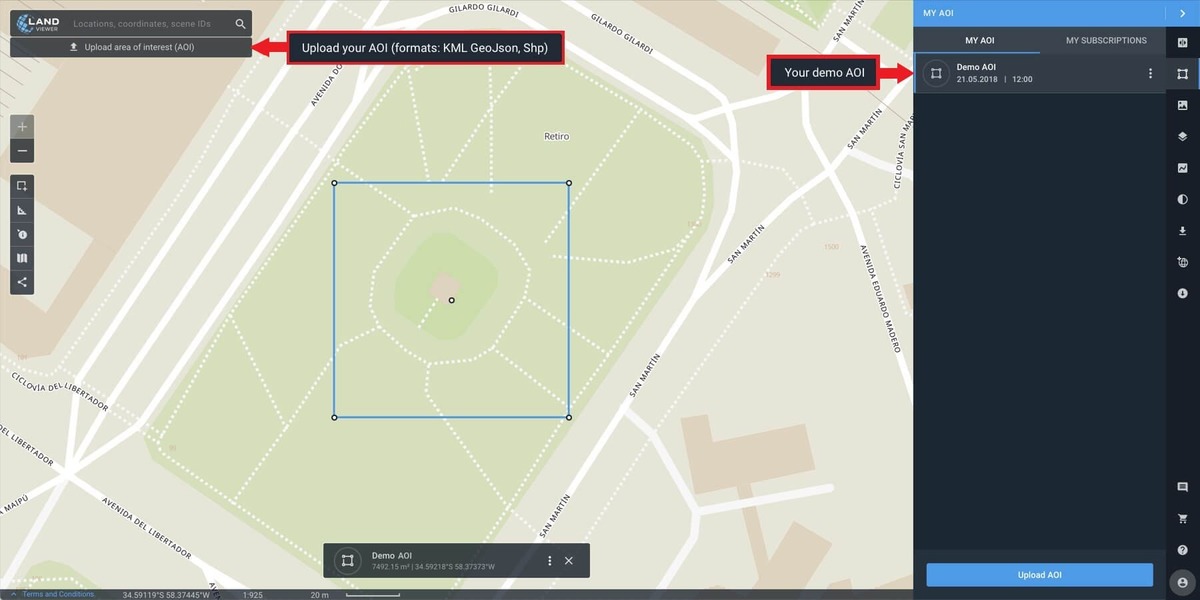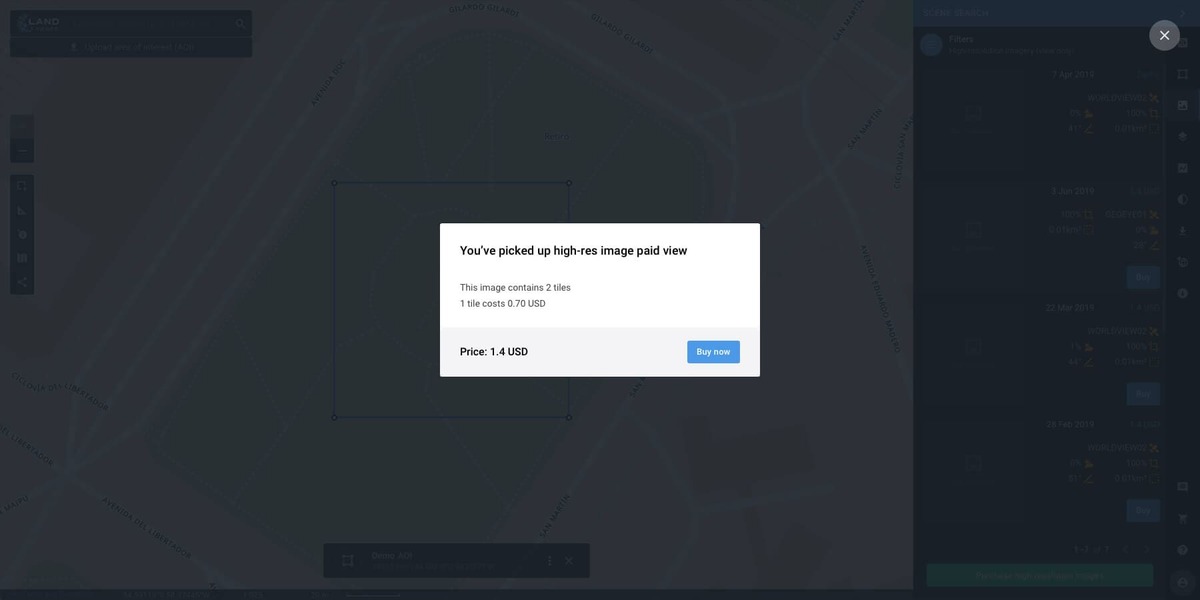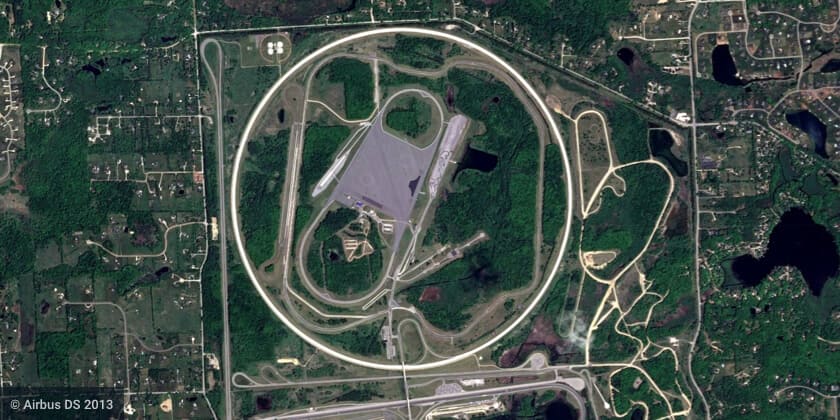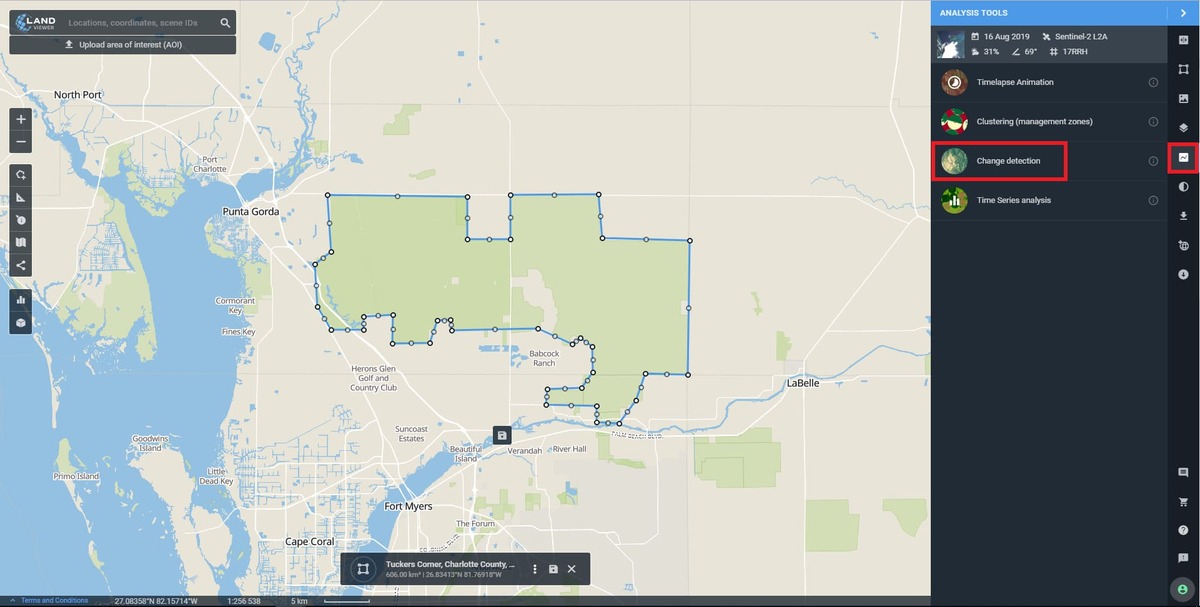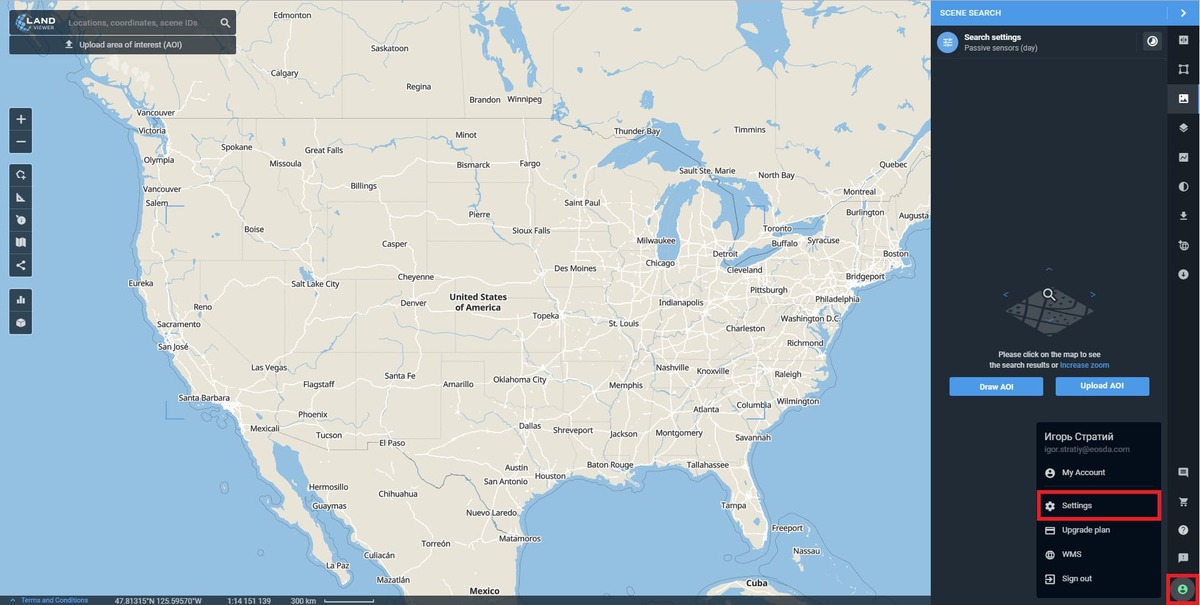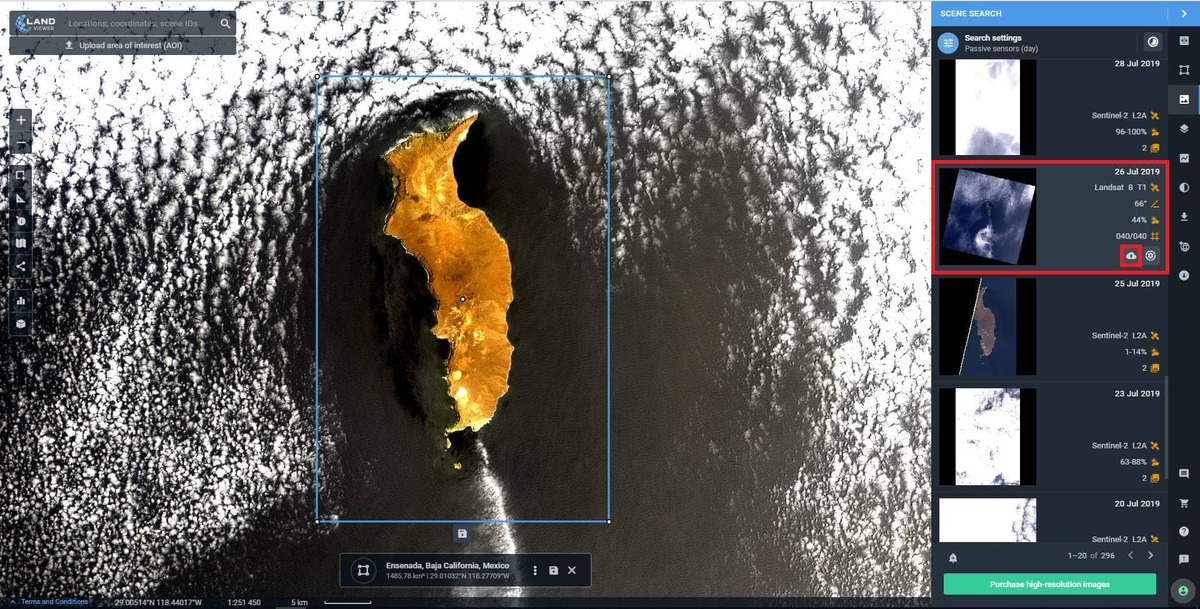High-resolution imagery (view only) has been recently launched as a stand-alone data source with an aim to make it accessible and usable for the everyday business user. It’s been designed to deliver high detail imagery that is affordable from just $0.7 per tile.
For this purpose, our software collects a huge amount of fresh satellite imagery, acquired by the partners’ sensors with a resolution of 30 and 40cm, this means when images are viewed in the EOSDA LandViewer’s platform, 1 pixel on the screen represents 30cm – 40cm on the ground.
Such imagery is much cheaper than high-resolution images intended for analytics. The price is based on the number of tiles within your AOI. To obtain such imagery, please take some simple steps:
1. Set your AOI (upload, draw). The list of High-resolution (view only) imagery generates according to the specified AOI. We also added one demo AOI, which already contains the list of the most suitable high-resolution images for you to test how it works. Try it prior to adding your own one.

2. Please note that the preview is not available for high-resolution imagery (view only). Thus, you will have to be guided by the image parameters, which are given on the image preview card, make sure this is the image you need prior to paid viewing. Do not forget to check metadata, displayed once you hover over the selected image. Make sure the image covers 100% of your area of interest.

3. On the preview card, you can find such parameters as the image cloudiness percentage, the Sun elevation angle and the area of overlap between the image and your AOI presented both – in percent and in square kilometers. Once you have selected the most suitable image just hit the Buy button and payment pop-up with the information on the number of tiles, the price for 1 tile (0.7$) and the final price for viewing the image will appear. Once you confirm viewing, your account will be charged a single amount, based on the number of the tiles within your AOI.

4. After clicking Buy now you will proceed to the payment details. Once you click the image and make the payment, the available for viewing high-resolution image will appear on the map. You can find the purchased scenes in the storage for you not to pay twice for viewing the same image, just activate the appropriate switch in the menu.

Applied fields
Construction Development – visualize and detect changes in the construction work as well as define the dynamics of such changes. It especially comes in use for the companies who invest in construction projects abroad and mainly in countries with a tense political situation as it is much easier to buy several images and spend a few minutes to compare them, than involve experts for monitoring of construction sites, thereby wasting the most valuable resources – time and money.
Natural disasters – keep an eye on environmental changes around the Globe – melting of glaciers, changing the coastlines, assess the damage caused by fires, floods, earthquakes, identify abnormals in the state of water resources and plant life, etc.
Agriculture – monitor your crops, yields and land cover. Visualize and track the changes in land cover, vegetation, field state, crop rotation, assess losses, predict risks among others.
Deforestation – the service provides the ability to keep in sight the changes of forest cover and watch over logging companies. It also helps to assess the damage caused by illegal logging.
Pre-assess damage – evaluate the damage caused by man-made and natural disasters fast and timely, comparing the pre- and post-disaster images.
GeoEye-1 Satellite Sensor
On September 6, 2008, using the Delta II launch vehicle, the GeoEye-1 satellite was successfully launched from Vandenberg Air Force Base, California. Formerly known as OrbView-5, GeoEye-1 is a remote sensing satellite owned by DigitalGlobe. GeoEye-1 is capable of acquiring images of the Earth’s surface with a 0.46 meter panchromatic and 1.84 meter multispectral resolution. Geoeye-1 is orbiting Earth at an altitude of approximately 681 kilometers and produces imagery with a ground sampling distance (GSD) that allows to detect objects of 46 centimeters or larger. This sensor has been optimized for major projects, as it can produce over 350,000 sq. km of high-res, pan-sharpened multispectral satellite imagery every day.
GeoEye-1 sensor specifications:
| Launch date: |
September 6, 2008 |
| Resolution: |
0.41 m/1.5 ft panchromatic
1.84 m/6.04 ft multispectral |
| Swat width: |
15.2 km/9.44 mi |
| Orbital altitude: |
770 km/478 miles |
| Orbit type/period: |
Sun-synchronous/98 minutes |
| Inclination/Equator crossing time: |
98 deg/10:30 am |
| Provider: |
DigitalGlobe |
GEOEYE-1 acquisition on May 23, 2018:

https://eos.com/landviewer/?lat=48.13226&lng=11.58299&z=19&preset=highResolutionTmsSensors
WorldView-1 Satellite Sensor
The WorldView-1 satellite was successfully launched on September 18, 2007 from Vandenberg Air Force Base, California using the Delta II launch vehicle. WorldView-1 is a next-generation commercial imaging satellite owned by DigitalGlobe that operates at an altitude of 496 kilometers above Earth and has an average revisit frequency of 1.7 days. The Satellite can collect up to 750,000 sq. km of panchromatic imagery every day. The sensor provides highly detailed imagery for a wide spectrum of applications such as precise map creation, change detection and in-depth image analysis (note that imagery must be re-sampled to 50 cm for non-US Government customers). WorldView-1 provides commercial imagery with a resolution of 0.50 meters at nadir and 0.55 meters at 20° off-nadir.
WorldView-1 sensor specifications:
| Launch date: |
September 18, 2007 |
| Resolution: |
0.50 m GSD at nadir
0.55 m GSD at 20° off-nadir |
| Swat width: |
17.6 km at nadir |
| Orbital altitude: |
496 km |
| Orbit type/period: |
Sun-synchronous/94.6 minutes |
| Inclination/Equator crossing time: |
97.87 deg/10:30 am (descending node) |
| Provider: |
DigitalGlobe |
WorldView-1 acquisition on May 29, 2019:

https://eos.com/landviewer/?lat=30.04306&lng=31.23546&z=19&preset=highResolutionTmsSensors
WorldView-2 Satellite Sensor
WorldView-2 is a commercial imaging satellite of DigitalGlobe Inc. that was launched on October 8, 2009 from Vandenberg Air Force Base on the Delta II launch vehicle flying in the 7920 configuration. It is worth noting that WorldView-2 is the first high-res 8-band multispectral commercial satellite. Among these eight bands are three standard colors (red, green, blue) and four new bands (coastal, yellow, red edge, and near-infrared), as well as a stand-alone high-resolution panchromatic band. The satellite provides full-color images for spectral analysis, mapping and monitoring, land-use planning, disaster relief, exploration, defense and reconnaissance, visualization and simulation environments. WorldView-2 operates at an altitude of 770 km and is able to collect up to 1 million sq. km of high-res imagery every day. GSD in panchromatic is 0.46 m, and 1.84 m in multispectral. Among multiple technical advantages, the satellite has the ability to hold direct tasking, which means customers around the world can load their imaging profiles directly to the satellite.
WorldView-2 sensor specifications:
| Launch date: |
October 8, 2009 |
| Resolution: |
0.46 m GSD panchrom
1.84 m GSD multispectral |
| Swat width: |
16.4 km at nadir |
| Orbital altitude: |
770 km |
| Orbit type/period: |
Sun-synchronous/100 minutes |
| Inclination/Equator crossing time: |
98.4 deg/10:30 am (descending node) |
| Provider: |
DigitalGlobe |
WORLDVIEW-2 acquisition on May 16, 2019:

https://eos.com/landviewer/?lat=-33.86218&lng=151.20197&z=19&preset=highResolutionTmsSensors
WorldView-3 Satellite Sensor
WorldView-3 is the first multi-payload, super-spectral, high-resolution commercial satellite sensor owned by DigitalGlobe. The sensor was successfully launched on August 13, 2014 from Vandenberg Air Force Base on an Atlas V flying in the 401 configuration. The WorldView-3 sensor was licensed by the National Oceanic and Atmospheric Administration (NOAA) to gather, in addition to the standard Panchromatic and Multispectral bands, eight-band short-wave infrared (SWIR) and 12 CAVIS (Clouds, Aerosols, Vapors, Ice, and Snow) imagery. WorldView-3 provides 31 cm panchromatic resolution, 1.24 m MS (Multispectral) resolution, 3.7 m SWIR (Short-Wave Infrared) resolution, and 30 m CAVIS resolution. The satellite has an average revisit frequency of <1 day and is capable of collecting up to 680,000 sq. km per day.
WorldView-3 sensor specifications:
| Launch date: |
August 13, 2014 |
| Resolution: |
0.31 m panchrom
1.24 m multispectral
3.7 m SWIR
30 m CAVIS |
| Swat width: |
13.1 km at nadir |
| Orbital altitude: |
617 km |
| Orbit type/period: |
Sun-synchronous/97 minutes |
| Inclination/Equator crossing time: |
97.97 deg/1:30 pm (descending node) |
| Provider: |
DigitalGlobe |
WorldView-3 acquisition on February 19, 2019:

https://eos.com/landviewer/?lat=-33.86218&lng=151.20197&z=19&preset=highResolutionTmsSensors
WorldView-4 Satellite Sensor
WorldView-4, formerly known as GeoEye-2, is DigitalGlobe’s next very high resolution imaging satellite providing high resolution and color imagery to commercial, government and international customers. It was successfully launched on November 11, 2016 from Vandenberg Air Force Base Space Launch Complex 3E aboard an Atlas V rocket. WorldView-4 offers exceptional geolocation accuracy, i.e. customers are able to map natural and man-made features to better than <4 meter CE90 of their actual location on the Earth’s surface. The satellite orbits Earth at an altitude of 613 km and can revisit any point every 4.5 days. WorldView-4 is capable of perceiving objects as small as 31cm in the panchromatic and collect 4-band multispectral imagery at 1.24-meter resolution.
WorldView-4 sensor specifications:
| Launch date: |
November 11, 2016 |
| Resolution: |
0.31 m panchrom
1.24 m multispectral |
| Swat width: |
13.1 km at nadir |
| Orbital altitude: |
613 km |
| Orbit type/period: |
Sun-synchronous/97 minutes |
| Inclination/Equator crossing time: |
97.98 deg/10:30 am (descending node) |
| Provider: |
DigitalGlobe |
WorldView-4 acquisition on September 10, 2018:

https://eos.com/landviewer/?lat=48.13222&lng=11.58288&z=19&preset=highResolutionTmsSensors
Pleiades-1A and 1B Satellite Sensors
The AIRBUS Defence & Space Pleiades-1A satellite was successfully launched via Soyuz STA rocket from the Guiana Space Centre, Kourou on December 17, 2011. Pleiades-1B was launched from the same location and caught up with 1A on December 2, 2012. The satellite constellation provides orthorectified color data at 0.5 meter resolution and has a revisit frequency of approximately 1 day. Pleiades-1A and 1B are capable of covering a total of 1 million sq. km each (386,102 sq. miles) daily. Each satellite can acquire high-res stereo images in just one pass. Every sensor owns four spectral bands (R, G, B and IR) and defines image location with an accuracy of up to 3 meters. Another advantage of Pleiades is small acquisition time. Images can be requested 6 hours before they are acquired. This feature is well suited for situations where time plays a critical role, for example natural disasters or crisis monitoring. Pleiades-1A and 1B satellites are phased 180° apart in the same near-polar sun-synchronous orbit at an altitude of 694 km, enabling daily revisits to any point on the globe. This makes them ideal for mapping large scale areas (such as engineering and construction sites), monitoring of ag, industrial and military complexes, crisis zones and disaster areas, natural or man-made hazards etc.
Pleiades-1A, 1B sensor specifications:
| Launch date: |
December 17, 2011/December 2, 2012 |
| Resolution: |
0.50 m panchrom
0.50 m color (pansharpened)
2 m multispectral |
| Swat width: |
20 km at nadir |
| Orbital altitude: |
694 km |
| Orbit type: |
Sun-synchronous |
| Inclination: |
98.2 deg |
| Provider: |
Airbus Defence & Space |

SPOT-5 Satellite Sensor
SPOT-5 was successfully placed into orbit on May 4, 2002 from the Guiana Space Centre in Kourou by an Ariane 4 launch vehicle. The SPOT-5 satellite has an ideal balance between 2.5 meter high-resolution and wide-swath 60×60 km or 60×120 km coverage. Compared to its forerunners, SPOT-5 offered improved capacities, and additional cost-effective imaging solutions. The satellite’s capture bandwidth has become a key advantage, which allowed it to be effectively used in such tasks as medium-scale mapping, urban development planning and similar, oil and gas exploration, monitoring of natural disasters and crisis situations etc. The satellite stereo imagery offered by SPOT-5 is vital for creating 3D terrain models. The SPOT-5 satellite sensor was decommissioned as of March 31, 2015. Archived SPOT-5 Satellite Imagery remains available.
SPOT-5 sensor specifications:
| Launch date: |
May 4, 2002 |
| Resolution: |
2.5m from 2 x 5m scenes panchrom
5 m panchrom nadir
20 m SWIR |
| Swat width: |
60 km x 60 km to 80 km at nadir |
| Orbital altitude: |
822 km |
| Orbit type/period: |
Sun-synchronous/101.4 minutes |
| Inclination/Equator crossing time: |
98.7 deg/10:30 AM (descending node) |
| Provider: |
Airbus Defence & Space |

SPOT-6 Satellite Sensor
The SPOT-6 satellite sensor developed by AIRBUS Defence & Space was successfully launched on September 9, 2012 by a PSLV launcher from the Satish Dhawan Space Center in India. SPOT-6 is an Earth observing satellite that offers 1.5 m resolution panchromatic and 6 m multispectral (RGB and near-IR) imagery. The satellite provides responsive tasking, with six tasking plans per day and coverage of up to 3 million sq. km per day. Moreover, it has automatic ortho imaging with location accuracy of 10m CE90 using Reference 3D. The satellite also provides an opportunity to acquire stereo and tri-stereo acquisition of 60 km x 60 km scenes. SPOT-6 orbits at an altitude of 695 km in quadratic phase with Pleiades satellites.
SPOT-6 sensor specifications:
| Launch date: |
September 9, 2012 |
| Resolution: |
1.5m panchromatic
6.0 m multispectral |
| Swat width: |
60 km at nadir |
| Orbital altitude: |
695 km |
| Orbit type: |
Sun-synchronous |
| Inclination: |
98.2 deg |
| Provider: |
Airbus Defence & Space |

Some sections of your area of interest (AOI), especially it’s true in case of a large AOI, that covers several scenes as well as AOIs (no matter how large), which are located at the junction of the scenes, remain overboard, which leads to a partial analysis and loss of valuable insights. To approach this issue, EOSDA LandViewer has introduced the new Mosaic function – an easy-to-use feature that lets you combine daily satellite images from the same sensor for a set location, apply default or custom indices on the fly, and download the results for further analytics.
To get started with the Mosaic tool, please follow these simple steps:
1. At first set (find, upload, draw) your AOI. When done, in the Filters tab select the sensor, set Cloudiness and Sun Elevation values. If your AOI is not covered with a single image, the Mosaic will be automatically created to obtain the full coverage. The Mosaic icon indicating the number of scenes in mosaic is displayed in the image preview card.

2. Once the Mosaic is chosen you can apply various band combinations. Select the required one from the Band Combinations tab and it will be immediately applied to your image.

3. There is also a possibility of using Contrast Stretching tool. You can select it from the menu by clicking Contrast stretching tab. Once it’s done hit the Edit button and manually set the required parameters. You can apply changes for previewing and save them when the needed result is achieved.

4. You can share your mosaic by clicking the Share button in the tool-box on the left side of the screen. The system offers several sharing options – link creating or sharing via such platforms as Facebook, LinkedIn or Twitter.

Choosing the creation of a link option will lead to an opening of a preview window, with an ability to select file size (small, medium or large).

5. To download the Mosaic, go to the Scene Downloading tab. The preview card will appear on the top of the downloading tab. It displays the date, the sensor, cloud coverage, the Sun elevation angle, the number of scenes in the Mosaic. Three types of downloads can be applied to Mosaic, these are – Visual, Analytics or Indices, depending on the user’s request.

- In case you select the Visual type, the resulting data will be delivered in the shape of JPEG, KMZ, GeoTIFF file, containing the merged scenes (e.g. all the scenes that fall into the AOI and don’t intersect.);
- The download result with the Analytics type will be an archive of the merged bands without metadata, for example (GeoTiff1: B02, GeoTiff2: B03, GeoTiff3: B04, GeoTiff4: B05.);
- With the Indices type, the result data for the mosaic will be presented as a TIFF file.
In the Scene Downloading menu, you can select the resolution of the image and its format. Select one of the suggested resolutions (S ~ 649×452 px 40 m/px, M ~ 1299×905 px 20 m/px, L ~ 2598×1810 px 10 m/px or XL ~ 5196×3620 px 5 m/px) that display ground sampling distance and the most suitable file format (JPEG, KMZ or GeoTIFF).

There is also an option to download by crop. To use this function you should enable the Crop image switch at the bottom of the Scene Downloading menu and stretch the bbox to set the area you want to download. In case the crop parameters are not set, all scenes are downloaded fully.

Once you select all needed settings, click the Download button at the bottom of the menu and you will see a pop-up displaying the start of the downloading. Also, please note that if you want to crop beyond the territory, covered by your AOI, the image will nevertheless be saved within the set AOI. The download limit for one file is 2 GB.
Applied fields
Agro monitoring: identify crop yields on a large scale, assess multiple fields all-in-one, no matter what territory they occupy, apply different vegetation indices and build fertilizers for all your fields at once, analyze your territories without data loss – sowing, watering, weather risks as well as farming equipment map.
Natural disasters: assessment of natural and man-made disasters impact. Fire monitoring, identification of droughts, defining of the damaged areas with the help of specific indices on a large territories. Observe floods and detect their sources no matter how far they are.
Coastal monitoring: analysis of coastal zones of long extent, monitoring of coastline changes, bathymetric analysis of water bodies as a whole through comparsion of images from different times, monitor melting of glaciers no matter how big they are, watch out for arctic rivers change.
Construction: monitoring and change detection of construction development within a large area of interest, mostly it comes in use for companies who are going to put in action ambitious projects on a large areas to keep track of which using traditional methods is impossible. This feature will be extremely useful for road designers and constructors. Pave roads guided by the latest up-to-date images composed in a convenient mosaic without any displacements or losses.
Forestry: monitoring of illegal deforestation on a large scale using mosaic approach to assess the damage of such activities.
The objective of Change Detection is to compare the spatial representation of two points in time by controlling all variances caused by differences in variables that are not of interest and to measure changes caused by differences in the variables of interest. Change detection for GIS is a process that measures how the attributes of a particular area have changed between two or more time periods, comparing two satellite images taken at different times. Change detection has been widely used to assess deforestation, urban growth, the impact of natural disasters and land cover changes etc.
To get started with the Change Detection function, please follow several simple steps:
1. Firstly set/upload/draw your area of interest (AOI). Once it’s done, in the FILTERS tab select the sensor, set Cloudiness and Sun Elevation values. After that, go to Analysis Tools menu and click Change Detection.
NB You need to select the scene to make the Change Detection active.

2. Once the first image is chosen, it appears on the map in the left side of the Comparison slider, while the right part contains the search panel to find the second image. When you get started with searching, a prompt message on how to proceed in a proper way occurs in the right menu. The Cloudiness is set up to 30% and the data source is chosen accordingly to the first image sensor by default. Use the buttons L / R to switch between the images on the slider.

3. At this step, please select the second image, dating from a different period of time to detect and assess the changes happened. Once both images appear on the map, click the Change Detection button to access the feature’s menu.

4. Choose the index you want to detect the changes for from the list in the Indices drop-down menu. To make whatever setting’s changes Click the “Back to scene search” button in the right upper menu. You can also check both images metadata and switch between the images on the map clicking the thumbnail pictures in turn. In order to select the necessary index go to Band combination drop-down menu. The scenes are displayed in “natural color”.

5. Once all the options are set, click Calculate. The outcome image is displayed over the originals ones. Once it is calculated, a slider to change the transparency of the difference layer appears on the map, and, below you can find the Change Detection Legend, displaying the index values by different colors. In our case, the resulting image shows positive changes in NDVI values.

6. Now you can either download the image in .png, .tiff or .jpeg format on your device or save it to your EOSDA Storage account.

With Time Series Analysis, you can visualize the data dynamics, constructing a spatiotemporal time series vegetation indices (VI) graph. The approach is widely employed in regional vegetation growth dynamics observation, phenological crop identification, land use change detection, etc. To use the Time Series Analysis is easy. You just need to set the AOI, time period and vegetation index. Once the graph is built, check the metric details of the selected Scene, Preview it on the map and download the result data as Excel file for further processing.
To get started with Time Series Analysis, take the following steps:
- Set the AOI (maximum processing area – 200 km2) and click the Time Series Analysis icon

- Choose the spectral index (NDVI, NDWI, NDSI) from the drop-down menu in the Time Series section on the top of the graph. Then select the sensor from the drop-down menu and time period; time intervals of (1, 3, 6, 12) months and (3, 5, 10) years are set by default. To build analytics with the selected parameters click Apply


- click Figure or Table on the right of the graph to download the result data as CSV file for further processing



- Left-click the point on the graph to check the metric details of the particular Scene, that is Source Data, Cloudiness, Mean, P10/P90, Median, sd, Min / Max

- To Preview the result, click Visualize in the top right of the image and the selected Scene shows up on the map


EOSDA LandViewer is connected to Airbus SE via API, therefore you can preview high-res satellite images, select the one that fits your AOI most and purchase it. The procedure is as follows:
- Set the AOI and select High resolution imagery (for analytics) category in the Source drop-down menu of All Filters tab. Apply the other filters

Preview the available scenes on the map and check the details. The price is given in US dollars and highlighted in green. It also provides you with the information about the area of intersection between the selected image and your AOI the final price is based on. In other words, the larger the area of intersection, the higher the price charged. Select the necessary images and click Add to cart.

Check the adding progress status, which is displayed in the bottom right of the screen. Once the process is completed, the notification In cart shows up in the image field.

Click Your Cart icon to check the order.

In the cart box specify the number of end-users in License field, tick the EULA (End-User License Agreement) box to confirm you agree to terms and click Submit.
NB We also offer a flexible discount system that depends on the number of images as well as the size of the area purchased.

The notification box shows up once your request is successfully sent. Once all the purchased details are agreed, the payment link or invoice shows up in the middle of the screen. When the payment is received, the image is distributed it to your EOSDA Storage account within three business days. At this step, you can download the purchased high-resolution satellite images directly from the EOSDA Storage.

Create a three-dimensional representation of your AOI with a powerful visualization tool – 3D Terrain Modeling. How to use it:
- set the AOI, select the Terrain layer and click the 3D Modeling icon in the toolbar on the left

- wait a few seconds until 3D Modeling is in progress

- customize your 3D Model, using (+) and (-), the mouse buttons and keyboard arrows

Zoom in to view the terrain details

To make a 3D Model of the satellite image, set the AOI, select the image and apply 3D Modeling feature

Wait a few seconds until 3D Modeling is in progress and navigate the Model according to your needs

With WMS (Web Maps Serviсе) you can integrate EOSDA LandViewer data into 3rd party tool. Using the function, browse the imagery from EOSDA LandViewer directly in your desktop or online software applications like QGIS, ArcGIS, EOSDA Vision, etc. for further processing
*To add the data to WMS you should have a client with WMS 1.3 protocol support only
To get started with WMS, take the following steps:
- Set the AOI and click add to WMS layer in the context menu

- Once it’s done, in the special WMS box set the Date, check the specifications and click Add to get a wms url link

- Copy it and use for further processing whenever you need

To check, edit and copy the list of your WMS links, stored in the section, go your Profile settings and select WMS


To view and compare two images from one or several satellites, use the Comparison slider that splits the screen into two parts. You can also apply the band combinations and spectral indices. To use it:
- set the AOI
- process the image according to your needs
- click Comparison slider in the right sidebar
- once the screen is split into 2 parts (the left part – the processed image, the right one – the base map), repeat the workflow described above.
- move the slider left and right to change the size of the parts

Another progressive functionality is designed to specify definite, averaged in definite index ranges, zones within the AOI, with clear boundaries, displaying the results of zone parameters’ calculation and the ability to export them to other software.
How it works
The tool transforms a high-resolution raster map into zones that share common index values. As a result of clustering + vectorization, you will get two new layers within the selected AOI. The first one is a raster layer containing the zones, which are highlighted with respective color and their boundaries determined by the same color. And the other one is vector layer, which contains b/w image, where each particular zone is indicated by a black color outline, and the detailed information about each zone that can be exported directly to a shapefile for further processing in other applications.
1. To get started with Clustering, you should draw your AOI using the tool-box on the left, choose the data source and select the image, covering your AOI 100%.

2. Once it’s done, click Clustering icon on the right

3. Select the Band combination from the drop-down menu, set the number of Classes (zones) and the Minimum zone area you are going to analyze. After that make step 1 and apply Show preview to display the results of raster zone calculation.

4. Make step 2 and click Calculate metrics to start vector calculation. Once the calculation is completed, the results are saved in your EOSDA Storage account by default. To download the layers on your device, click the Download button in the bottom menu.

5. To check the metrics details of the specific zone, left – click any place of the selected zone. Manage color and borders setting using Fills and Borders buttons respectively. Choose the downloading geo-format from the list available.

Applied fields
Agro monitoring: identification of high/low crop yield and affected vegetation areas, different types of vegetation areas to build fertilizers, sowing/resting, watering as well as drones’ routes and farming equipment map.
Coastal monitoring: analysis of coastal zones, coral reefs to assess and analyze water temperature, salinity, phytoplankton, hydrology, changes in coastline, bathymetry, soil moisture as well as potential threats to shores.
Forestry: identification of specific zones by vegetation density, vegetation type, monitoring of deforestation yet together with the vegetation change dynamics using time series approach.
